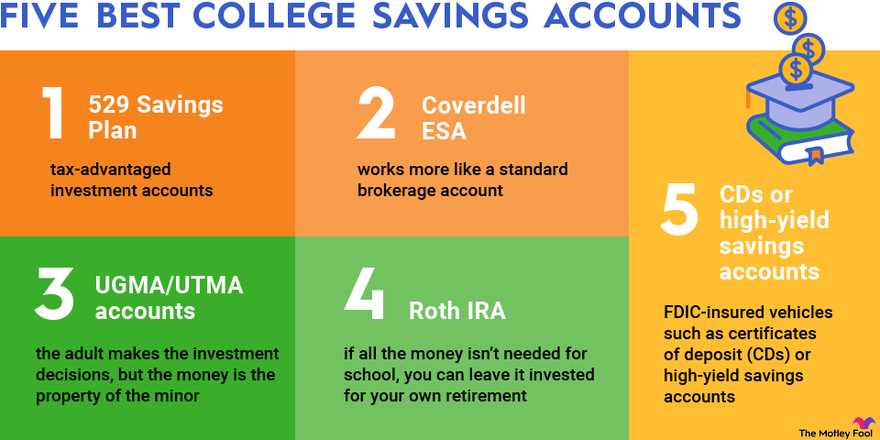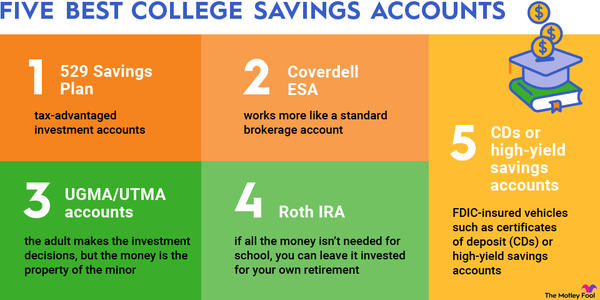There are several different ways you can choose to save for college, and the right solution for you might be one or a combination of them. Here are the five top ways to set aside money for college and what you should know about each one.

Five best college savings accounts
Five best college savings accounts
1. 529 savings plan
1. 529 savings plan
A 529 savings plan is the most popular type of college-specific investment account, and for good reason.
For one thing, 529 savings plans are tax-advantaged investment accounts. While you don’t get a federal tax deduction for contributions, your investments can grow tax-free, and any qualified withdrawals are non-taxable, regardless of how much your investments have grown.
In addition, 529 savings plans are run by the states, so depending on where you live, you might be able to get a state tax deduction for your contributions.
As far as investments go, 529 plans work like most 401(k)s. You’ll have a selection of investment funds and pre-selected portfolio options to choose from, and contribution limits are high. Most 529 plans allow you to contribute money until the account reaches $400,000 (or much more, in some cases).
2. Coverdell ESA
2. Coverdell ESA
A Coverdell Education Savings Account, or Coverdell ESA, is the other major type of education-specific investment account. Unlike a 529, which functions like most workplace retirement plans, a Coverdell works more like a standard brokerage account. You can open a Coverdell through many popular brokers, and you can use money in a Coverdell to invest in stocks, mutual funds, exchange-traded funds (ETFs), bonds, and more.
Coverdell ESAs have the same general tax structure as 529 savings plans. Contributions aren't deductible, but you don't have to pay tax on dividends or capital gains each year, and qualified withdrawals are tax-free.
This investment flexibility is the main advantage of using a Coverdell. With a 529 savings plan, you are limited to the plan's "menu" of investment options. With a Coverdell, if you want to invest some of your college savings in, say, Apple (AAPL -0.35%) stock, you can certainly do it.
The biggest drawback to a Coverdell ESA is the contribution maximum of just $2,000 per year. And this limit is per beneficiary, not per account. In other words, if you and your child's grandparents both open Coverdell accounts for your child, the combined contributions can't exceed $2,000 per year. And, if your income exceeds a certain threshold, the ability to contribute at all phases out -- for 2023 and 2024, the contribution phase-out starts at a modified gross adjusted income of $190,000 for married couples filing jointly and $95,000 for other taxpayers.
Advantages of using a Coverdell ESA
- Money in a Coverdell ESA can be invested in virtually any stock, mutual fund, or ETF you want.
- Coverdell ESAs can be easily opened through most major online brokerages.
- Investments in a Coverdell ESA grow tax-free, and qualifying withdrawals are completely tax-free.
Potential drawbacks of a Coverdell ESA
- Only $2,000 can be contributed to a Coverdell ESA per beneficiary, per year.
- Money in a Coverdell ESA must be used for qualifying educational expenses or face a penalty.
- Contributions to a Coverdell ESA are not deductible on state or federal tax returns.
3. UGMA/UTMA accounts
3. UGMA/UTMA accounts
Two account types that can be especially useful for college savings are Uniform Gift to Minors Act (UGMA) and Uniform Transfer to Minors Act (UTMA) accounts.
These accounts work just like standard brokerage accounts. You can put money in a UGMA or UTMA and invest it just like you would your own investment portfolio, in stocks, bonds, mutual funds, ETFs, etc. But these accounts allow adults to invest on behalf of minors. They are also known as custodial accounts since the adult has the ability to make investment decisions, but the money is technically the property of the minor. Depending on the account terms, the minor is given control of the money when they turn 18 or 21.
This can be both a good thing or a bad thing. Keep in mind that although you may have set aside money specifically for college, your child can choose to use the money for whatever they want after they reach the age of maturity for the account. What's more, money in a UGMA or UTMA can have negative implications for financial aid since assets owned by the child are weighted more heavily in the expected family contribution formula than assets owned by the parent.
Advantages of using a UGMA or UTMA account
- Money in a UTMA or UGMA can be invested in virtually any stock, bond, ETF, or mutual fund.
- UGMA or UTMA funds can be used for any purpose the account beneficiary wants, not just education.
- A UGMA or UTMA can be a way to give money to a minor and avoid estate tax implications (up to $17,000 per year in 2023, or $18,000 per year in 2024).
Potential drawbacks of a UGMA or UTMA account
- The account beneficiary can choose to use the money in a UGMA or UTMA account for anything they want, not just education.
- Money in a UGMA or UTMA becomes the legal property of the beneficiary, not the person who contributed the funds and can have negative implications for financial aid eligibility.
- There are no tax advantages associated with a UGMA or UTMA account.
4. Roth IRA
4. Roth IRA
It might sound odd to suggest using a Roth IRA as a college savings account, but it could make more sense than you think.
For starters, there is a special exemption that allows IRA account holders to withdraw money penalty-free to pay for qualified higher education expenses. And a Roth IRA has the same general tax structure as a 529 savings plan or a Coverdell ESA -- money is contributed on an after-tax basis, and investments within the account grow and compound tax-free.
There are a few benefits of using a Roth IRA to invest for college. For one thing, you have more investment flexibility than a 529 since you can invest in any stocks, ETFs, mutual funds, or bonds you want. And with an annual contribution limit of $6,500 in 2023 ($7,500 if you're 50 or older) and $7,000 in 2024 ($8,000 if you're 50 or older), you can put more money in than with a Coverdell.
Also, one of the biggest drawbacks to using a 529 or Coverdell is that the money has to be used for education, or you'll face a stiff penalty for withdrawing it. And with a UGMA or UTMA, the money becomes your child's property whether they need it for college or not. By using a Roth IRA to save for college, if your child doesn't need all the money to pay for school, you can simply leave it invested for your own retirement.
Advantages of using a Roth IRA
- Roth IRAs have the same general tax structure as 529 plans and Coverdell ESAs, but the money doesn't have to be used for education.
- If your kids don't need the money for college, you can simply use it for your own retirement.
- Money in a Roth IRA can be invested in virtually any stock, bond, ETF, or mutual fund you want.
Potential drawbacks of a Roth IRA
- No state tax deduction for contributions.
- If not used for college, there are few ways to withdraw money before retirement age.
- Contributions are limited to $6,500 in 2023 ($7,500 if you're 50 or older) and $7,000 in 2024 ($8,000 if you're 50 or older).
5. CDs or high-yield savings accounts
5. CDs or high-yield savings accounts
If you don't like taking risks, you can choose to put some or all of your college savings in risk-free, FDIC-insured vehicles such as certificates of deposit (CDs) or high-yield savings accounts. These can be an especially attractive option when the stock market is volatile, and we're in a relatively high-interest-rate environment.
These aren't just for risk-averse savers. Even if you are a rather aggressive investor, it can make sense to move some of your college savings into CDs or savings accounts as your child gets close to college age. After all, it's one thing to deal with a 25% drawdown in your investments when your child is 5 years old. It's quite another to deal with large investment losses when your child needs tuition paid in a few months.
Interest Rate
Advantages of using a CD or high-yield savings account
- Extremely safe -- virtually no risk of losing money.
- Returns can be high when interest rates rise.
- No limit to the amount of money you can contribute.
Potential drawbacks of a CD or high-yield savings account
- Low risk means low reward potential.
- Virtually no returns in low-interest environments.
- Maximizing CD yields involves keeping your money tied up.
Related investing topics
Why should you start saving for college early?
Why should you start saving for college early?
The short answer is that the earlier you start, the easier it will be. As an example, let’s assume you just had a baby, and you’d like to pay for them to go to college in 18 years. We’ll also assume that you average 7% annual returns on your investments over time and that you’d like to have $100,000 in the account by the time your child is 18.
With all of that in mind, consider these stats:
- If you start saving and investing for college when your child is born, you’d have to set aside about $245 per month to have a good chance of meeting your $100,000 savings goal.
- If you wait until your child is 5 years old, you’d need to save $413 every month to achieve the same end result.
- If you don’t start saving until your child is 10 years old, your monthly savings would need to be $812 to reasonably expect a $100,000 ending balance.
Of course, these are simplified examples, and your returns will fluctuate from year to year. But the point is that the earlier you start, the less you’ll need to save each month to put yourself in a great position to achieve your goals.
The bottom line on college savings plans
The bottom line on college savings plans
As you can see, there are several excellent options when it comes to saving for college, but the most important thing is that you come up with a solid plan and get started as soon as possible. The best account types for you depend on your goals and risk tolerance, but these five options should give you plenty to work with.
College savings accounts FAQs
College savings accounts FAQs
What type of account is best for college savings?
It depends on your savings goals and risk tolerance, along with your own investment expertise. 529 savings plans, Coverdell ESAs, UGMA/UTMA accounts, IRAs, and CDs can all be excellent choices, and the right plan for you could be a combination of these.
What are the disadvantages of a 529 plan?
The two major disadvantages of using a 529 plan to save for college are investment flexibility and the requirement to use the money for educational expenses. You are generally limited to a selection of investments offered by your plan, and unless you use the money for qualifying education expenses, you could have to pay a 10% IRS penalty.
What happens to a 529 plan if the beneficiary doesn’t go to college?
If the beneficiary of a 529 doesn’t go to college or doesn’t need all of the money in the account, there are two main options. First, the account owner can change the beneficiary to someone else, such as a sibling, niece/nephew, etc. Second, the account owner can choose to withdraw the money themselves, but doing so is likely to result in a 10% penalty.










